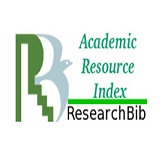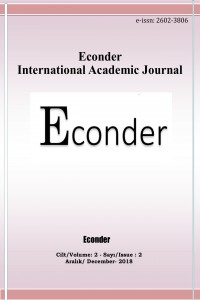Öz
Günümüzde, bazı sosyal, yasal ve
ekonomik nedenlerden dolayı tersine lojistik ile uğraşmak birçok endüstride
kaçınılmaz durum olmuştur. Ürün iadelerinin toplanması ve geri dönüştürülmesi,
dünya çapında işletmecilerin ve araştırmacıların ilgi duyduğu bir konu haline
gelmiştir. Bu çalışmanın amacı gıda sektöründe tersine lojistik faaliyetlerinin
başarısında büyük rol oynayan kritik faktörlerin değerlendirilmesidir.
Çalışmada çok kriterli karar verme tekniklerinden olan DEMATEL tekniği
kullanılmıştır. Veriler gıda sektöründe faaliyet gösteren büyük ölçekli bir
firmadan alınmıştır. Elde edilen verilerin analizi ve bulguların yorumu
neticesinde, genel olarak sistem üzerinde en baskın olan faktör üst yönetimin
bağlılığı iken sistem üzerinde etkinliği en az olan faktör süreç planlaması
olarak belirlenmiştir. Ayrıca ilişki yoğunluğu açısından ön plana çıkan
faktörlerkalite yönetimi, üst yönetimin bağlılığı, kaynak yönetimi
ve lojistik ağ tasarımı olarak belirlenmiştir.
Anahtar Kelimeler
Tersine Lojistik Lojistik DEMATEL Çok Kriterli Karar Verme Gıda Sektörü
Kaynakça
- Agrawal, S., Singh, R. K., & Murtaza, Q. (2015). A literature review and perspectives in reverse logistics. Resources, Conservation and Recycling, 97, 76-92.
- Alshamsi, A., & Diabat, A. (2017). A Genetic Algorithm for Reverse Logistics network design: A case study from the GCC. Journal of Cleaner Production, 151, 652-669.
- Bahiraei, N., Panjehfouladgaran, H., & Yusuff, R. M. (2015, March). Ranking of critical success factors in reverse logistics by TOPSIS. In Industrial Engineering and Operations Management (IEOM), 2015 International Conference on (pp. 1-5). IEEE.
- Chang, B., Chang, C. W., & Wu, C. H. (2011). Fuzzy DEMATEL method for developing supplier selection criteria. Expert systems with Applications, 38(3), 1850-1858.
- Chen, J.K. ve Chen, S., (2010). “Using a novel conjunctive MCDM approach based on DEMATEL, fuzzy ANP, and TOPSIS as an innovation support system for Taiwanese higher education”, Expert Systems with Applications 37. ss.1981-1990.
- Daugherty, P. J., Richey, R. G., Genchev, S. E., & Chen, H. (2005). Reverse logistics: superior performance through focused resource commitments to information technology. Transportation Research Part E: Logistics and Transportation Review, 41(2), 77-92.
- Daugherty, P. J., Autry, C. W., & Ellinger, A. E. (2001). Reverse logistics: the relationship between resource commitment and program performance. Journal of business logistics, 22(1), 107-123.
- De Brito, M. P., Flapper, S. D. P., & Dekker, R. (2002). Reverse Logistics: a review of case studies. Econometric Institute.
- Dekker, R., Fleischmann, M., Inderfurth, K., & Van Wassenhove, L. N. (2005). Reverse logistics: Quantitative models for closed-loop supply chains. Journal-Operatıonal Research Socıety, 56(6), 752-752.
- Dethloff, J. (2001). Vehicle routing and reverse logistics: the vehicle routing problem with simultaneous delivery and pick-up. OR-Spektrum, 23(1), 79-96.
- Eyüboğlu, G., & Bastı, M. (2017). Tersine lojistikte karşılaşılan sorunlar ve çözüm önerileri-Türk gıda sektörü örneği
- Fleischmann, M. (2001). Reverse logistics network structures and design.
- Fleischmann, M., Bloemhof-Ruwaard, J., Dekker, R., Van der Laan, E., van Nunen, J., & Van Wassenhove, L. (1997). Quantitative models for reverse logistics. European journal of operational research, 103, 1-17.
- Guide Jr, V. D. R., & Van Wassenhove, L. N. (2001). Managing product returns for remanufacturing. Production and operations management, 10(2), 142-155.
- Liou, J. H., Tzeng, G. H., ve Chang, H. C. (2007). “Airline Safety Measurement Using A Hybrid Model”, Journal of Air Transport Management, 13. ss.243-249.
- Murphy, P. (1986). A preliminary study of transportation and warehousing aspects of reverse distribution. Transportation Journal, 12-21.
- Paksoy, S., (2017). “Çok Kriterli Karar Vermede Güncel YaklaĢımlar”, Karahan Kitabevi, 1. Baskı, 117s.
- Prahinski, C., & Kocabasoglu, C. (2006). Empirical research opportunities in reverse supply chains. Omega, 34(6), 519-532.
- Sangwan, K. S. (2017). Key activities, decision variables and performance indicators of reverse logistics. Procedia CIRP, 61, 257-262.
- Tavana, M., Zareinejad, M., Di Caprio, D., & Kaviani, M. A. (2016). An integrated intuitionistic fuzzy AHP and SWOT method for outsourcing reverse logistics. Applied Soft Computing, 40, 544-557.
- Tibben-Lembke, R. S., ve Rogers, D. S. (1998). Going backwards: reverse logistics trends and practices. Reverse Logistics Executive Council.
- Tibben-Lembke, R. S., & Rogers, D. S. (2002). Differences between forward and reverse logistics in a retail environment. Supply Chain Management: An International Journal, 7(5), 271-282.
- Toffel, M. W. (2003). The growing strategic importance of end-of-life product management. California Management Review, 45(3), 102-129.
- Tzeng, G. H., Chiang, C. H., ve Li, C. W. (2007). Evaluating intertwined effects in e-learning programs: A novel hybrid MCDM model based on factor analysis and DEMATEL. Expert systems with Applications, 32(4), 1028-1044.
Öz
Nowadays, for
some social, legal and economic reasons, dealing with reverse logistics is
inevitable situation in many industries. Product collection and recycling has
become an issue of interest to operators and researchers worldwide. The aim of
this study is to evaluate the critical factors that play a major role in the
success of reverse logistics in the food sector. DEMATEL technique, which is
one of the multi-criteria decision making techniques, was used in the study.
The data were collected from a large-scale company operating in the food
sector. As a result of the analysis of the obtained data and the interpretation
of the findings, in general, the most dominant factor on the system was the
dependency of the top management, while the least effect on the system was
determined as the process planning. In addition, factors that stand out in
terms of relationship intensity; quality management, commitment of senior
management, resource management and logistics network design.
Anahtar Kelimeler
Reverse Logistics Logistics DEMATEL Multi Criteria Decision Making Food Sector
Kaynakça
- Agrawal, S., Singh, R. K., & Murtaza, Q. (2015). A literature review and perspectives in reverse logistics. Resources, Conservation and Recycling, 97, 76-92.
- Alshamsi, A., & Diabat, A. (2017). A Genetic Algorithm for Reverse Logistics network design: A case study from the GCC. Journal of Cleaner Production, 151, 652-669.
- Bahiraei, N., Panjehfouladgaran, H., & Yusuff, R. M. (2015, March). Ranking of critical success factors in reverse logistics by TOPSIS. In Industrial Engineering and Operations Management (IEOM), 2015 International Conference on (pp. 1-5). IEEE.
- Chang, B., Chang, C. W., & Wu, C. H. (2011). Fuzzy DEMATEL method for developing supplier selection criteria. Expert systems with Applications, 38(3), 1850-1858.
- Chen, J.K. ve Chen, S., (2010). “Using a novel conjunctive MCDM approach based on DEMATEL, fuzzy ANP, and TOPSIS as an innovation support system for Taiwanese higher education”, Expert Systems with Applications 37. ss.1981-1990.
- Daugherty, P. J., Richey, R. G., Genchev, S. E., & Chen, H. (2005). Reverse logistics: superior performance through focused resource commitments to information technology. Transportation Research Part E: Logistics and Transportation Review, 41(2), 77-92.
- Daugherty, P. J., Autry, C. W., & Ellinger, A. E. (2001). Reverse logistics: the relationship between resource commitment and program performance. Journal of business logistics, 22(1), 107-123.
- De Brito, M. P., Flapper, S. D. P., & Dekker, R. (2002). Reverse Logistics: a review of case studies. Econometric Institute.
- Dekker, R., Fleischmann, M., Inderfurth, K., & Van Wassenhove, L. N. (2005). Reverse logistics: Quantitative models for closed-loop supply chains. Journal-Operatıonal Research Socıety, 56(6), 752-752.
- Dethloff, J. (2001). Vehicle routing and reverse logistics: the vehicle routing problem with simultaneous delivery and pick-up. OR-Spektrum, 23(1), 79-96.
- Eyüboğlu, G., & Bastı, M. (2017). Tersine lojistikte karşılaşılan sorunlar ve çözüm önerileri-Türk gıda sektörü örneği
- Fleischmann, M. (2001). Reverse logistics network structures and design.
- Fleischmann, M., Bloemhof-Ruwaard, J., Dekker, R., Van der Laan, E., van Nunen, J., & Van Wassenhove, L. (1997). Quantitative models for reverse logistics. European journal of operational research, 103, 1-17.
- Guide Jr, V. D. R., & Van Wassenhove, L. N. (2001). Managing product returns for remanufacturing. Production and operations management, 10(2), 142-155.
- Liou, J. H., Tzeng, G. H., ve Chang, H. C. (2007). “Airline Safety Measurement Using A Hybrid Model”, Journal of Air Transport Management, 13. ss.243-249.
- Murphy, P. (1986). A preliminary study of transportation and warehousing aspects of reverse distribution. Transportation Journal, 12-21.
- Paksoy, S., (2017). “Çok Kriterli Karar Vermede Güncel YaklaĢımlar”, Karahan Kitabevi, 1. Baskı, 117s.
- Prahinski, C., & Kocabasoglu, C. (2006). Empirical research opportunities in reverse supply chains. Omega, 34(6), 519-532.
- Sangwan, K. S. (2017). Key activities, decision variables and performance indicators of reverse logistics. Procedia CIRP, 61, 257-262.
- Tavana, M., Zareinejad, M., Di Caprio, D., & Kaviani, M. A. (2016). An integrated intuitionistic fuzzy AHP and SWOT method for outsourcing reverse logistics. Applied Soft Computing, 40, 544-557.
- Tibben-Lembke, R. S., ve Rogers, D. S. (1998). Going backwards: reverse logistics trends and practices. Reverse Logistics Executive Council.
- Tibben-Lembke, R. S., & Rogers, D. S. (2002). Differences between forward and reverse logistics in a retail environment. Supply Chain Management: An International Journal, 7(5), 271-282.
- Toffel, M. W. (2003). The growing strategic importance of end-of-life product management. California Management Review, 45(3), 102-129.
- Tzeng, G. H., Chiang, C. H., ve Li, C. W. (2007). Evaluating intertwined effects in e-learning programs: A novel hybrid MCDM model based on factor analysis and DEMATEL. Expert systems with Applications, 32(4), 1028-1044.
Ayrıntılar
| Birincil Dil | Türkçe |
|---|---|
| Konular | İşletme |
| Bölüm | Makaleler |
| Yazarlar | |
| Yayımlanma Tarihi | 30 Aralık 2018 |
| Yayımlandığı Sayı | Yıl 2018 Cilt: 2 Sayı: 2 |
Cited By
ATIK YÖNETİMİNDE KRİTİK BAŞARI FAKTÖRLERİNİN DEMATEL YÖNTEMİYLE DEĞERLENDİRİLMESİ
Uluslararası İktisadi ve İdari İncelemeler Dergisi
https://doi.org/10.18092/ulikidince.1168685
"Econder International Academic Journal" Ekonomi ve İşletmenin tüm yönleriyle ilgili bilimsel makaleler yayınlamaya adanmış uluslararası hakemli bir multidisipliner dergidir. Yılda iki kez çevrimiçi olarak sunulan ve yayınlanan dergide, Ekonomi ve İşletmenin tüm alanlarındaki yeni bulgular ve tartışmalar için dünyanın önde gelen platformlarından biri olmayı hedefliyoruz.





